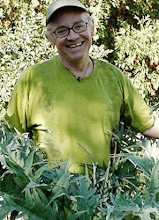 The Planting Board in Use
The Planting Board in Use







Rain, Goldfinches in summer plumage, and Dandelions all mark the advancement of our spring. These April rains will green the grass and trees. The birds are in a nest building flurry taking cotton and twine that I have hung in the apple trees for them. At a Master Gardener program this week I learned that Ruby-throated Hummingbirds are already back and now would be a good time to hang out the feeders. The speaker indicated that "cane sugar syrup" is their favorite in a mixture of four to one ( H2O/C6H12O6) Shortly the Baltimore Orioles will be back too, so now is the time to watch for grape jelly on sale at the store and stock up. Its amazing how much the birds will eat and not just Orioles, I have seen Grackles and House Sparrows taking their share too.
The garden is really wet but in advance of the rain I got some much needed clean-up done and some planting as well. Now it will be a while before I can get back as the soil is really drenched and my heavy clay will not tolerate walking on or working in - easy to make bricks that way.
I sorted the small onions that I saved from last years crop and sized them for planting. I had some small seed grown shallots, some Cipollini "Gold Coin", and what look like Red Long Of Tropea type. I set these bulbs out in short rows (see photo) and then inter-planted with lettuce. The transplanting video briefly shows close up the lettuce plants planted in the spaces between the onions. I planted half a flat into this area and the rest of the plants went into the spaces between the developing rhubarb plants that were grown from seed last year. All this is very typical of how we plant. Our space is a premium, so getting the most out of any planting is my goal. The lettuce will be harvested from the space before the onions really need all the room. The onions are also planted close so that I can harvest and thin at the same time.
I inter-planted the onions with four types of lettuce transplants - Simpson's Elite, Derby and Winter Density, along with a few plants of Tom Thumb a nice small bibb type. Most of these transplants look thick but I did not thin them on purpose - plant clumps and you have a measured amount for harvest.
The harvest of spinach continues as well as the first mini-radishes. Spinach has sprouted in another cold frame and that frame has two plantings spaced two weeks apart to stretch that harvest. The sorrel is moving along and so are chives. There are now many goodies to add to morning scrambled eggs. Tarragon is up but not enough to start a harvest.
Seeds are a wonderful thing. I got some "White Star"zinnia seed at a lecture about seed viability two years ago. The seed was dated 2004. Last summer I planted some and it grew so I tried it again this season and it grew again! and still better than 50% germination. So if you have seed from other seasons give it a try. You might be very pleased.
This week's garden project was to make a new Planting Board. This is, like my cold frames, something I constantly use in the garden. You will need a 1inch by 6inch by 6 foot pine board.
I round one edge ( see pictures) to act as a furrow maker. I use a small hand plane to do the job. If you are good with a saw you could work the edge that way too. I sand my results and then mark off one foot and six inch spaces for my planting notches on the opposite side. I do not make these real deep as that weakens the space in between and might cause that part of the board to break off. Measure the large notches 2 inches long by 1 1/2 inches deep; measure the small notches 1 inch long by 1 inch deep. Saw out your notched and you are done. Use the photo set for a reference. I use a 6 foot board because I seldom make a row longer than twice that dimension. I prefer short rows and multi repeat plantings to get the longest harvest of a crop. The board helps to plant row crops like beets and carrots along with other plantings like tomatoes and peppers. A planting board is a great garden tool and you can make one for less than $5. I don't treat the board, I just let it age with use. The one in the photo is probably four or five years old. To borrow a phrase - it's a very good thing.
Happy Gardening
Transplanting lettuce seedlings

No comments:
Post a Comment